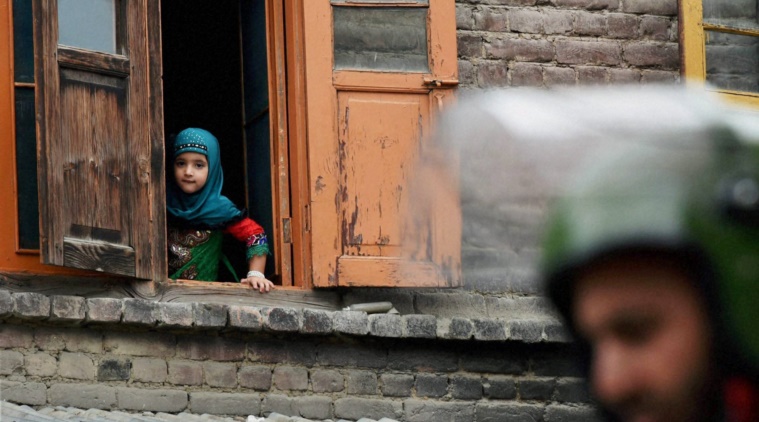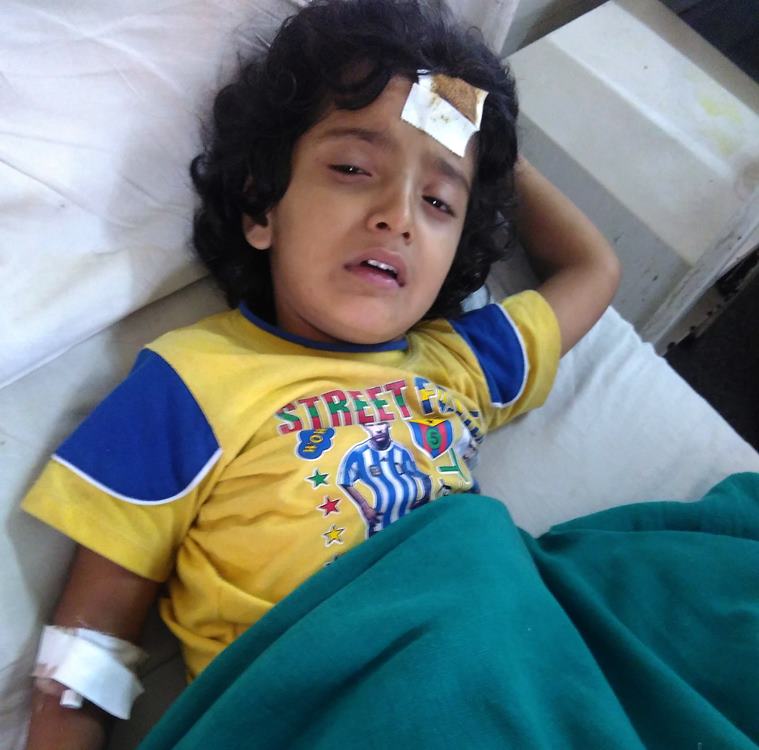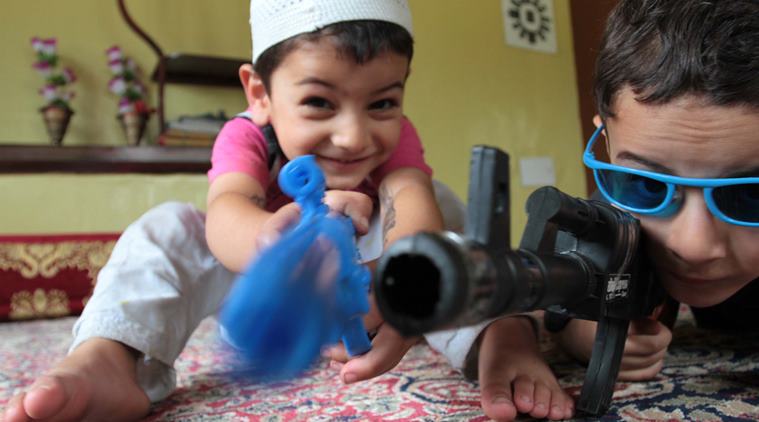
Violence has cast a long shadow on children of the Valley
Just another day in Kashmir for a child is often not about school, fun and games. In this summer of disquiet, violence has cast a long shadow on the children of the Valley.
 From the sound, I can tell you whether the bullet has been fired in the air or at someone. I can even tell you whether it has been fired from an AK-47 or SLR. The sounds of the tear-smoke shell and the pellet gun may be subtly different but I can make it out.”
From the sound, I can tell you whether the bullet has been fired in the air or at someone. I can even tell you whether it has been fired from an AK-47 or SLR. The sounds of the tear-smoke shell and the pellet gun may be subtly different but I can make it out.”
Thirteen-year-old Muawin Tasneem is in his home in Zainakote, a neighbourhood on the outskirts of Srinagar city. Outside, there is only the silence of the curfew, which has been on since July 9. The streets are deserted as are the playgrounds. A narrow lane branching off the Srinagar-Baramulla national highway leads to a cluster of houses named Ghalib Abad, where he lives.
Though Muawin, the child of a banker and a teacher, says he has never been part of a protest, the highway, just a hundred metres away from his house, is a battleground between protesters and the paramilitary forces. “By sitting at home, I can escape the pellets and bullets but not their sounds or the slogans raised by the protestors,” he says. “There are times when the smell of tear smoke and pepper gas enters the house.”
“Outside the Valley, when you hear a bang, you take it for a firecracker, for a celebration. But here, it is something to worry about — you think about an explosion, a bullet going off, a pellet or a tear-smoke shell. A firecracker is the last thing you think of,” he says.
Muawin is a Class VIII student in one of the top schools of the city but he last attended classes on June 30. The school has not reopened after the summer vacations as violence took over the city after the killing of Hizbul Mujahideen militant Burhan Wani.
Muawin idles through his days and makes occasional attempts at studying. “Life is boring,” he says. “What can you do when you can’t move out? I get up in the morning and spend a few hours on my study table. But even that is half-hearted. I eat and play games on the cellphone. These days, I can’t even play Clash of Clans because there is no internet. I have to be content with Score Hero (a mobile soccer game). In the evening, if it is not windy, I play badminton with my brothers.” A patch of earth inside the walled premises of their house serves as the badminton court.
The window panes are overrun by scribbles, which speak of the frustration of the Valley’s teenagers: “Respect the existence or expect the resistance”; “Never a slave”; “When oppression becomes a fact, revolution becomes a right”. “My elder brother has written these,” says Muawin, about his 20-year-old brother, Minhaj, who is a student of Amar Singh College in Srinagar.
 A girl looks out from a window during curfew in Srinagar on Tuesday.
A girl looks out from a window during curfew in Srinagar on Tuesday.
The siblings have grown up with the presence of paramilitary forces in the city and curfews that interrupt their daily life. “We have always seen soldiers around us, right from childhood. When you see something from childhood, it looks perfectly normal until you grow older and realise this is different from the rest of world,” says his 17-year-old brother Muarij. “When I grew up, I felt that to have a securityman on every street is not normal,” he says.
Childhood in Kashmir is, all too often, like a small strip of land sandwiched between innocence and bitter knowledge. While the cycle of protests and reprisals is not new, nor the sight of teenagers hurling stones at the paramilitary forces, the recent cycle of police action has seen children being grievously injured by pellets. Five-year-old Zohra Farooq was hit by pellets on her leg when she stepped out of her house in Qamarwari, Srinagar. Two children playing cricket in Anantnag were riddled with pellets when police fired at protesters.
Aatif Farooq, a 17-year-old from Srinagar, simmers with rage at what he sees around him. His friend Zahid was one of the protestors. “What then? Was that the justification for the CRPF to fire pellets into his eyes? They have ruined his life. His family has already spent Rs 2 lakh on him.”
 Five-year-old Zohra Farooq lying on a hospital bed after she suffered pellet injuries in Srinagar last week.
Five-year-old Zohra Farooq lying on a hospital bed after she suffered pellet injuries in Srinagar last week.
In 2010, the death of a school student, Tufail Mattoo, from a tear-smoke shell fired by security forces had triggered a fierce wave of protests against the government and the army. How does the clear and present danger of injury shape children and their lives, their education and playtime? How does the frequent shutdown of schools affect them? (Valley schools were shut for almost a month and a half in 2008, and for more than three months in 2010.)
“What I understand by normalcy is different from someone who lives outside,” says Ummat, 15, from Jawahar Nagar in Srinagar. “A shutdown in a week, stone pelting or even a gunbattle is normal for me. For us, the meaning of childhood has changed. It is more about survival than enjoyment,” she says. When she leaves for school, Ummat gets a full set of instructions from her mother: “Don’t walk past the bunker; come back early”. Ummat wants to become a doctor but her passion is cricket. “I wanted to be a cricketer but that will remain a dream,” she says.
“After school, I head straight home. If I am late because of some work or stuck in traffic, my cellphone will ring constantly. It’s my mother asking where I am. Last year, I went to Delhi with my father and we would stay out till late. For the first few days, I was surprised not to get a call from my mother,” says Ummat.
While he occasionally goes to the market for shopping or dinner with her family, that is unheard of in Sopore, one of the most prosperous towns of Kashmir. Sopore was a militant bastion for a long time before they shifted their base to south Kashmir. “When I watch serials like Taarak Mehta Ka Ooltah Chashmah, I feel the difference between our childhood and of those living outside the Valley,” says Taha Javed, a 16-year-old Class X student from the town. “We have nowhere to go. On normal days, the shops shut by 5 pm. The only playground we have is surrounded by three camps — of the police, the CRPF and the army.”
The disquiet of parents is evident in South Kashmir, the epicentre of a new wave of militancy and the current upsurge. “I am always worried about my children. They are in their early teens. They often talk about the boys killed or injured, they talk about oppression. You may have seen that video, that’s the new reality of Kashmir,” says Nazir Ahmad Mir of Pulwama. He is referring to a video, where children play the role of militants and army men during an encounter. A young boy in the video calls his family during the encounter to say he is “likely to get martyred” and that his brother should pick up the gun after him. Mir has two sons —15 and 17 years old. “I sometimes think I should send them outside for studies but then I look at my nephews. Ever since they went to Delhi, they have become more radical. They talk about what Kashmiri students go through there. They talk about polarisation in Delhi,” he says.
The past few weeks, especially, has seen childhood interrupted. “We live in constant fear,” says Mueiz Farooq, a 14-year-old Class VII student. “It is difficult to concentrate on our studies. My parents keep me locked inside. They try to keep me away from the streets so that I am not killed or injured in the protests. But then slogans (blaring from mosque loudspeakers) make way into my room, somebody shouts about a killing or an injury. I get restless”.
Mueiz’s father Farooq Ahmad Wani is also restless. “Every day, you hear that a teenager has been killed or injured. Being a father, I can feel that pain. But that doubles when your son is also a teenager. You are always worried for him. It is true that I don’t let him to go out on the streets. You may call it selfish, but I am a father,” he says.
Whenever Wani, a government employee, hears about a killing or a protest, his first job is to call home and find out where his son is. “He is of the age where he would be tempted to go out. I talk to him, try to persuade and motivate him to stay indoors. But for how long? I don’t know,” he says.
 A shutdown outside and strict curbs by parents at home only multiply the anxiety of children. “We feel like being in jail all the time,” says Mudasir Firdous, 13, a Class VII student from Rawalpora in Srinagar.
A shutdown outside and strict curbs by parents at home only multiply the anxiety of children. “We feel like being in jail all the time,” says Mudasir Firdous, 13, a Class VII student from Rawalpora in Srinagar.
Cooped up at home, they have fewer options to spend time. Those, too, are shaped by the environment they live in. “My cousins and I play ‘army-mujahid’ in our house or Project IGI [a tactical first-person shooter game] on the computer,” says Fatima, who is eight years old. For Mueiz, the evenings revolve around cartoons on television.
In times of relative peace, the playgrounds are filled with the voices of children, and life does not have to measured out by curfew-free hours. Despite that, the shadow of violence is a long one. In most places, the markets close by dusk and people rush home early. Kashmiris go about their lives, inured to frequent checks by securitypersons and their overwhelming presence on the streets. There is no nightlife and television is the only means to de-stress.
“We know one thing for sure: the environment does impact the children and it then manifests itself in adulthood,” says psychiatrist Dr Arshad Hussain, who has counselled several children traumatised by the loss or disappearance of a parent or a relative. “If a boy sees violence in childhood, it will only beget violence,” he says.
For many of the children, then, it is impossible to be insulated from the violence on the street, the tear-smoke shell exploding at the nearest corner. “My parents lock me inside the room but I slip out of the window,” says Aatif, “I throw a few stones and return home.”

